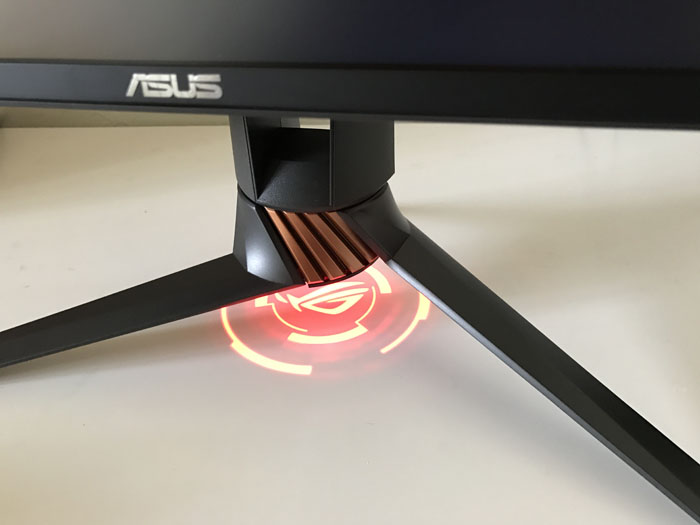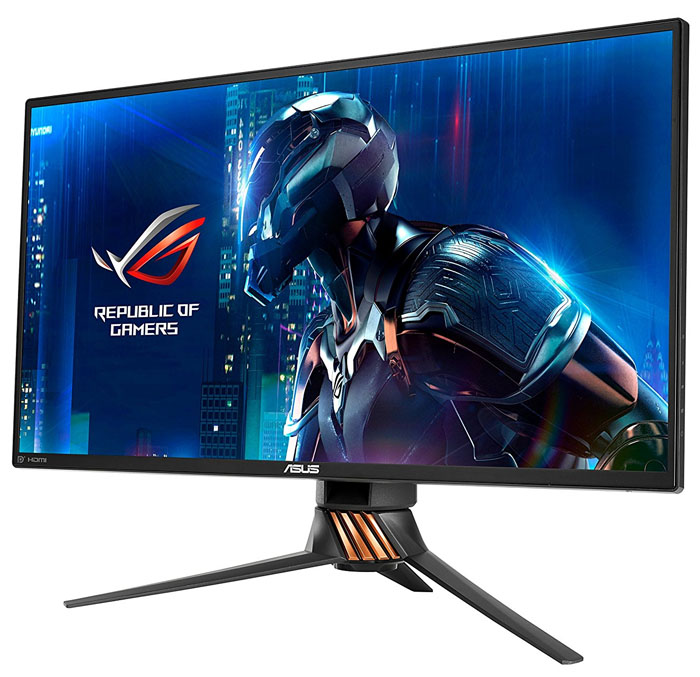Tom's Hardware Verdict
Some users may balk at paying a lot of money for a TN monitor, but one look at the PG258Q’s gaming prowess will quickly change their minds. For sheer playability, this display is the finest we’ve reviewed so far. Control response and motion quality are on another plane of existence when compared to most other gaming screens. Once calibrated, color and contrast are among the best. The styling is a matter of personal taste, but Asus’ starship/steam-punk thing is growing on us. If you’ve just dropped a lot of money on your gaming rig, the PG258Q is a perfect finishing piece. We could keep extolling its virtues but we’d rather get back to gaming.
Pros
- +
240Hz without overclock
- +
Excellent ULMB implementation
- +
High light output
- +
G-Sync
- +
OSD joystick
- +
Styling
Cons
- -
Expensive
- -
Out-of-box color and gamma
- -
Excessive ghosting at top overdrive setting
Why you can trust Tom's Hardware
Features & Specifications
Ever since the original Asus VG248QE was introduced, the race towards higher refresh rates has continued unabated. It seems only recently we saw the first 160Hz screens in our lab. Now Asus has broken new ground with its first 240Hz display, the ROG Swift PG258Q. But that isn’t the whole story. It also sports G-Sync from 24-240Hz, ULMB up to 144Hz, and a host of features sure to appeal to enthusiasts.
Right off the bat, some of you are saying “not another TN panel!” But stick with us here, it’s not so bad. For starters, it’s one of the nicest TN screens we’ve ever seen. Viewing angles look far better than pretty much any other TN display we’re aware of. And our photos on page five support that. And yes, it uses Frame Rate Compensation (FRC) to take its native 6-bit color depth to 8-bits. But thanks to that, the PG258Q has the lowest input lag we’ve ever measured. Again, page five has the details.
Specifications
MORE: Display Calibration 101
MORE: The Science Behind Tuning Your Monitor
The feature list is just what you’d expect from Asus’ premium ROG line. You get ULMB, and it works up to 144Hz. The panel is bright enough that output remains high in both G-Sync and ULMB modes. And you can take advantage of independent brightness settings to keep levels matched. Another improvement is the elimination of the refresh overclock feature. You can simply choose 240Hz in Nvidia Control Panel rather than rebooting the monitor to change rates.
Held over from other ROG screens is the GamePlus feature with its reticles, timers, FPS counter, and screen alignment guide. Asus has also retained the excellent OSD joystick navigation and styling cues reminiscent of something you’d see on the deck of a starship. It’s a premium package at a premium price, but so far it seems like you’re getting your money’s worth. Let’s take a look.
Packaging, Physical Layout & Accessories
The carton is quite substantial and more than capable of protecting its expensive contents. Rigid foam surrounds the panel and attached upright. The metal base, input panel cover, and cable bundle reside in a top tray. Those cables include HDMI, DisplayPort, and USB 3.0. The power supply is external and looks like a miniature Apple TV.
Get Tom's Hardware's best news and in-depth reviews, straight to your inbox.
Assembly requires only that you screw the base on with a captive bolt. You can also snap lenses in place that work with the Light In Motion feature to project colored patterns onto your desk. More on that below.
Product 360





To me the panel says “starship” while the base says “steam punk.” The same accents we first saw on the PG348Q ultra-wide are here on the PG258Q. The base has copper-colored trim, which continues around back on a large ring that surrounds the panel/upright interface. It seems there is no VESA mount, so you’ll have to use the included hardware.
The screen is surrounded by a very thin bezel that measures just 7mm on the sides, which is great for multi-monitor setups. The top is slightly wider at 9mm, and the bottom goes to 13mm. No lighting is visible on the front except for a tiny power LED at the lower right edge. It glows red for G-Sync, green for ULMB, and white for Normal mode.
Control keys are around back and are topped by a slick joystick that makes OSD navigation a snap. Our only nit-pick is the power button feels the same as the others and is not separated from them. It’s too easy to accidentally turn off the monitor when you’d rather pop up the GameVisual menu. It has a different texture though, so if you’re careful, you’ll soon get the hang of it.
Like other ROG Swift monitors, the PG258Q has a Light In Motion effect. It takes the form of a small LED that projects a colored symbol on your desktop. It has three intensity levels, or you can turn it off.
Styling dictates a somewhat thick panel with a rounded taper across the back. There are no speakers, nor are there side USB inputs. One upstream and two downstream (version 3.0) ports reside on the bottom-facing input panel. Also there are one each of HDMI and DisplayPort along with a 3.5mm headphone output. Once you’ve plugged in all the cables, an included cover snaps on to hide the jacks. Cable management is aided by a hole in the upright.
MORE: Best Computer Monitors
MORE: How To Choose A Monitor
MORE: All Monitor Content

Christian Eberle is a Contributing Editor for Tom's Hardware US. He's a veteran reviewer of A/V equipment, specializing in monitors. Christian began his obsession with tech when he built his first PC in 1991, a 286 running DOS 3.0 at a blazing 12MHz. In 2006, he undertook training from the Imaging Science Foundation in video calibration and testing and thus started a passion for precise imaging that persists to this day. He is also a professional musician with a degree from the New England Conservatory as a classical bassoonist which he used to good effect as a performer with the West Point Army Band from 1987 to 2013. He enjoys watching movies and listening to high-end audio in his custom-built home theater and can be seen riding trails near his home on a race-ready ICE VTX recumbent trike. Christian enjoys the endless summer in Florida where he lives with his wife and Chihuahua and plays with orchestras around the state.
-
apertotes I just don't get it. How can you leave the contrast (arguably the most importante feature on a screen after the resolution) out of the first page of the article? I couldn't care less about the bezel width, but please, state the contrast!Reply -
ahnilated 1080P, *sigh* who wants this anymore! Get me a 4K monitor at 30-32" with good specs and G-Sync that isn't $4000.Reply -
dstarr3 Reply19637653 said:1080P, *sigh* who wants this anymore! Get me a 4K monitor at 30-32" with good specs and G-Sync that isn't $4000.
Because that's the reality of GPUs at the moment. GPUs can get you a solid 4K/60 or a solid 1080p/144. You're not going to get 4K/144 in any modern games on any PC at the moment (unless you're only playing 20-year-old games). So there's not a lot of sense in wanting to invest in a 4K/144 monitor now, only in anticipation of when GPUs can finally push that many pixels, because you'll be wasting the monitor while you wait, and when such GPUs finally do arrive, the monitors will be better and cheaper. -
Rosanjin Do we know if this monitor is 3dVision capable?Reply
I would assume so, but I've learned some very expensive lessons by making purchases based on assumptions. : / -
ahnilated Reply19637717 said:19637653 said:1080P, *sigh* who wants this anymore! Get me a 4K monitor at 30-32" with good specs and G-Sync that isn't $4000.
Because that's the reality of GPUs at the moment. GPUs can get you a solid 4K/60 or a solid 1080p/144. You're not going to get 4K/144 in any modern games on any PC at the moment (unless you're only playing 20-year-old games). So there's not a lot of sense in wanting to invest in a 4K/144 monitor now, only in anticipation of when GPUs can finally push that many pixels, because you'll be wasting the monitor while you wait, and when such GPUs finally do arrive, the monitors will be better and cheaper.
The reason you won't get it is because the GPU's won't do it, not because the games won't. Game developers want to make more realistic games but the GPU's are lagging way behind. Nvidia hasn't had any real competition for many years so there was no need for them to push to 4K gaming at 144Hz or higher. I am hoping AMD's cards will force Nvidia to get off their buts as it seems the consumers aren't going to pull their money from Nvidia until Nvidia gets back on the ball. -
Geo Matrix I agree with AHNILATED! DSTARR3 says, "Because that's the reality of GPUs at the moment". I say let's have some serious change! Asus and Nvidia are "milking the cow" with these old relics. Everything is now going 4K, 6K and 8K. It's time to stop milking the cow and people's wallets and put out the new technology. It's 2017, not 1980. We all know the new tech is already here.Reply -
dstarr3 Based on the performance bump we saw from the 1080 Ti, I don't think it's fair to say that nVidia's slouching when it comes to GPU performance. Pricing, sure, they could use more competition. But something like 4K/144 is a seriously enormous amount of processing to do. The DisplayPort and HDMI interfaces themselves had to be updated to transfer that much data. I'm amazed we got 4K/60 out of GPUs as quickly as we did. Give it another generation and we should be hovering around 4K/144. But you ask why there's no 4K/144 gaming monitors coming out yet, and this is why. There aren't any 4K/144 GPUs out yet, either. And it's not because any particular company is stagnating. It's because pushing that many pixels to a monitor is a huge, huge task.Reply -
Deadshot-89 I use an Eizo EV 2336W. It has incredibly accurate and incredibly deep and vidid colors right out of the box. It also has a very deep picture and for an IPS screen very deep blacks. And to top it all off, it has extremely nice viewing angles, no color-shifts and it retains a ton of brightness at very steep angles. Motion performance is very OK for a 60 Hz screen.Reply
My current hardware isn't really capable of producing more than a reliable 1080p60. (GTX 970, i5-4590). So I see no reason to switch to a higher res screen or higher refresh rate screen.
